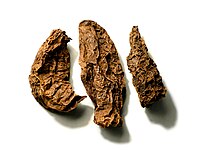 Loading... Please wait...
Loading... Please wait...
Blog - chipotle powder
Are you looking for chipotle? Here are some products.
Posted by Brighton Chilli Shop on 22nd Apr 2016
Are you looking for chipotle? Here are some products we have with it
A chipotle (/tʃᵻˈpoʊtleɪ/, chi-POHT-lay; Spanish: [tʃiˈpotle]), or chilpotle, which comes from the Nahuatl word chilpoctli (meaning "smoked chili"), is a smoke-dried jalapeño. It is a chili used primarily in Mexican and Mexican-inspired cuisines, such as Mexican-American, Tex-Mex, and southwestern dishes.
Varieties of jalapeño vary in size and heat. In Mexico, the jalapeño is also known as the cuaresmeño and gordo. Until recently, chipotles were largely found in the markets of central and southern Mexico. As Mexican food became more popular abroad, especially in the United States and Canada, jalapeño production and processing began to expand into northern Mexico to serve the southwestern United States, and eventually processing occurred in the United States and other places such as China.[citation needed]
Its heat is similar to that of the Espelette pepper, jalapeño, Guajillo chili, Hungarian wax pepper, New Mexican varieties of the Anaheim pepper, and Tabasco sauce.
Contents
Production
Typically, a grower passes through a jalapeño field many times, picking the unripe, green jalapeños for market. At the end of the growing season, jalapeños naturally ripen and turn bright red. In Mexico and the United States, there is a market for ripe red jalapeños. They are kept on the bush as long as possible. When they are deep red and have lost much of their moisture, they are picked to be made into chipotles.
The red jalapeños are moved to a closed smoking chamber and spread on metal grills. Wood is put in a firebox, and the smoke enters the sealed chamber. Every few hours the jalapeños are stirred to mix in the smoke. They're smoked for several days, until most of the moisture is removed. In the end, the chipotles have dried up in a manner akin to prunes or raisins. The underlying heat of the jalapeños combines with the taste of smoke. Typically, ten pounds of jalapeños make one pound of chipotle.[1]
In recent years, growers have begun using large gas dryers.
Varieties
Most chipotle chilis are produced in the northern Mexican state of Chihuahua.[2] This variety of chipotle is known as a morita (Spanish for small mulberry). In central and southern Mexico, chipotle chilis are known as chile meco, chile ahumado, or típico. Whereas moritas from Chihuahua are purple in color, chile meco is tan/grey in color and has the general appearance of a cigar butt. Most chipotle chilis found in the United States are of the morita variety. Almost all of the chipotle meco is consumed in Mexico.
Chipotles are purchased in forms, including chipotle powder, chipotle pods, chipotles en adobo in a can, concentrated chipotle base and wet chipotle meat marinade.
Other varieties of chilis are smoke-dried, including red jalapeños, serranos, habaneros, New Mexico chilis, Hungarian wax peppers, Santa Fe Grande chilis, and a milder jalapeño called the TAM (a cultivar named for Texas A&M University). Lesser-known varieties of smoked chilis include cobán, a piquín chile native to southern Mexico and Guatemala; pasilla de Oaxaca, a variety of pasilla from Oaxaca used in mole negro; jalapeño chico, jalapeños, smoked while still green; and capones ("castrated ones"), a rare smoked red jalapeño without seeds.
Use
Chipotles, often a key ingredient, impart a relatively mild but earthy spiciness to many dishes in Mexican cuisine. The chilis are used to make various salsas. Chipotle can be ground and combined with other spices to make a meat marinade, adobo. Chipotle is used (typically in powder form) as an ingredient in both homemade and commercial products, including some brands of barbecue sauces and hot sauces, as well as in some chili and stews. Usually when used commercially the product is advertised as having Chipotle in it.
Chipotles have heat and a distinctive smoky flavor. The flesh is thick, so the chilis are usually used in a slow-cooked dish rather than raw. Whole chipotles are added to soups, stews or in the braising liquid for meats. They can also accompany beans or lentils.


